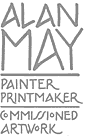 |
|
| PRINTS | |
| paintings | |
| drawings | |
| other media | |
| SOLO EXHIBITIONS |
|
| CONTACT | |
| about the artist | |
| commissions & pricing | |
| copyright Alan May 1974 - 2012 all rights reserved |
|
ORIGINAL PRINTS: ACCESSIBLE ART
A speech given by Alan May at the Commonwealth Club of California, 24 March 1996.
I'm going to speak to you this evening about why I find original prints to be such an engaging and accessible form of artwork. For the last 10 years, I've devoted a lot of time to studying prints, producing prints, and teaching other people how to make prints-- so you can tell that I am a big fan of printmaking. By the end of this short talk, I hope you'll share my enthusiasm and appreciate the power of prints even more. I'm going to talk for a few minutes here but afterwards, for those who are interested, I'll walk through the exhibition and illustrate more of my comments with examples hanging on the wall, as well as answer any questions you may have.
Why prints?
For the artist, printmaking gives access to a wide expressive vocabulary (there are many ways of depicting your message in a print). It also provides the possibility of producing multiple original works, rather than only one. For the viewer, prints provide access to the artist's message in a surprisingly familiar, modest, and personal format. Prints are easy to approach yet can be among the most sophisticated and subtle works of art.
What is a print?
Our lives are surrounded with prints. We are all print collectors. This [speaker shows a dollar bill] is a print. As is this [pulls out a picture postcard], and this [points to his printed cloth tie], as well as all the framed work in this exhibition. " If all of these things are prints, just what defines a print?", you ask. Glad you asked . A print is any work that is a transfered mark used to communicate the artist's vision. That is, it is not a direct mark as in a drawing or a painting. The fact that a print is a transferred mark allows the artist to make multiples of the original mark - either for greater distribution of a set image or for variations of the image.
Original prints
Obviously, prints can serve a variety of uses - from the superficial task of symbolizing payment to the more layered depiction of visual meditations. However, there are two categories of prints. Most prints that you see are reproductive prints. What I'm going to talk about here tonight are original prints. So what determines an original print? Is it the weighty "artistic" subject matter that determines an original print? No. Is it a high price tag? No. Does it have to have been made by some old famous dead guy? Perish the thought! What makes it an original print is that the artist has specifically chosen a printmaking method to express the message. It is made with the intent of being a primary artwork - it is the thing , not a copy of the thing.
Reproductive prints
The antithesis of an original print is a reproductive print. Instead of making an original statement, the sole purpose of the reproductive print is to copy an other artwork as faithfully as possible. It does not use the expressive qualities inherent in the medium. Just think of that poster of the Monet painting you like so much. Not quite as strong, as complete as the real thing, what? An original print, like the original Monet painting, is the real thing. If you run a $100 bill through a color Xerox machine, you get a counterfeit, reproductive print. If you use the capacity of the machine to change the color from green to pink, you can make an original print - the point of the print would not be to fool anyone, but to make a new statement (however stupid it may be!). To produce as opposed to re-produce.
An intimate experience...
So most people, whether consciously or not, are very familiar with prints. Another comfortable aspect of original prints is that traditionally they are scaled to be viewed by one person at a time. As you are walking around the exhibit, notice that it is necessary to get close to the prints. This intimate viewing distance encourages close examination. And close examination makes evident one of the most attractive aspects of prints - the unique physical melding of ink and paper. For instance - in an etching the inked lines are raised slightly above the surface of the uninked paper. This creates a physical difference that has a visual and emotional impact that cannot be duplicated in a reproduction.
The alluring marriage of paper and ink
In printmaking, the paper itself is a very significant part of the design. Paper can be colored (often very subtly) or textured with flecks of seaweed or rough or smooth or thin. In any case, the choice of paper is critical to the impact of the print upon the viewer. The paper is never disguised, as canvas may be for an oil painting. Once again, this physical component plays an important role in how the image makes the viewer feel.
The range of expressive techniques
So, enough about you - lets talk about me! Printmaking can be overwhelmingly attractive to an artist because of its seemingly limitless range of expressive tools. For instance, I can choose the broad, flat blacks of a linocut when I want sharp, raw contrast. I may choose the hair-thin lines of an etching when I want subtle detail. Aquatint allows me to establish areas of tone in a variety of appealing ways. I may choose a monotype when I want a particular kind of color or to approach the subject matter with a unique kind of spontaneity. Relief etching gives me a silvery line against an inky black. Each of these tools enables me to create an image that has a unique and deliberate kind of visual impact. When you've got a lot of things to say, this range of expression is really important.
The expressive tools are brought to life by the two key components common to all printmaking production: platemaking and printing. The plate holds the information for the printing ink and paper to record. Both are equally necessary. By changing one or the other of these components you can radically alter the type of print you produce. For example, you can make an etched plate and then print it in two different ways to get literally opposite results: an intaglio print or a relief print. ( I'll describe the differences in a moment.)
Platemaking
First of all, let's do the platemaking. The basic properties of a plate to be etched are very simple - an area is either open to the bite of the acid or protected from it. The thin metal plate (zinc or copper) is covered with an acid resistant coating - a ground. By removing areas of the ground as you draw with a scribe you open up lines of bare plate, which then can be bitten by the acid. Once the drawing ( the selective ground removal) is complete, the plate is put in the acid bath to bite. Taking the plate out of the acid bath and cleaning off the ground, you are left with a plate that has a smooth surface (untouched by the effect of the acid) interrupted by grooves where the ground was removed and the acid allowed to bite. So much for making the plate...
Printing --Intaglio vs. Relief
Now for the second half of the printmaking process - printing. And here is were you will see two compleatly different results from the same plate. Traditionally, this kind of etched plate is printed as an intaglio print - that is: ink is forced into the grooves and the surface is wiped clean, leaving only the inked grooves to print. The resulting print will have inked lines against a clean background. It is generally called an etching. Engravings, drypoints, aquatints,mezzotints and etchings are all traditionally printed with the intaglio process.
But now, watch this. Take the same etched plate but roll a thin film of ink onto just the bare surface and leave the grooves uninked. This printing process is know as relief printing and will give us white lines against a solid inked background - just the opposite of an intaglio print. This kind of thin white-lined print is called a relief etching. Woodcuts, linocuts, wood engravings and potato prints are all printed with the relief process - the ink applied to the even raised surface of the plate. Learning more about printmaking technique can help you appreciate why the artist choose to use a certain method. One of the joys of connoisseurship is appreciating how subtle elements can contribute to the success of the printed image.
States -- history set in paper
Besides the special look each technique has there is another quality that is unique to printmaking - states. Webster defines a state as a set of attributes characterizing a person or thing at a given time.
One of the advantages of printmaking over direct mark making (such as drawing, painting, etc.) is the ability to permanently document every step of the print's development. A drawing or a painting can only be presented in its present state (whether finished or in progress). Each stage of a print can be fully documented by printing state proofs as the print progresses. Make an image on a plate, print the plate-- there's a state. Make a change to the plate and thereby to the image, print the plate, and there's another state documented.
You can have multiple, very successful images from the same plate, created at different stages. The prints of NYC in the show are an example: I found the first state (a soft ground line deliniation) so appealing that I ran a small edition of that state before completing the aquatinted tone work of the final editioned state. With state proofs, the viewer can also see the evolution of the artist's thinking, including changes in direction or refinement of the image.
Editions
This discussion of proofs and editions leads me to comment on something that I'm afraid mystifies more viewers than it should - the limited edition. Historically, a print would be printed until the plate or demand wore out. However, during the prosperous print market of the 1880's a device was established to limit the number of each print on the market - instant rarity!
The limited edition, a set number of prints that look relatively identical, was born. Each of the prints in an edition was assigned a specific number written as a fraction over the number of prints in the whole edition (5/20). Yet the assumption that number 1 is the first (and therefore the freshest) of the edition is mistaken; because the printer strives to make all the prints look like each other, the prints are usually just numbered randomly.
The edition numbers are just a sign of commercial rarity - not a sign of intrinsic worth. And does this rarity make it a successful, compelling artwork? Obviously, no. Just because original prints can deliver a message in a familiar and intimate way doesn't mean that every print will wisely utilise the medium's unique qualities. The criteria for judging an original print should be the same as for any other form of artwork - does it have relevance, sincerity, depth, clarity and mystery. Can you access a meaningful message?
As an artist, original prints have provided me with vocabulary that can be both friendly and significant. I hope that this little chat and my enthusiasm for the subject will make it even easier to for you to seek out all the treasures held in original prints.
Thank you and please enjoy the exhibition.
 |
| A printmaker, circa 1990 |
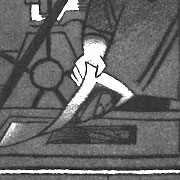 |
| Viewing the transfered mark of printing. |
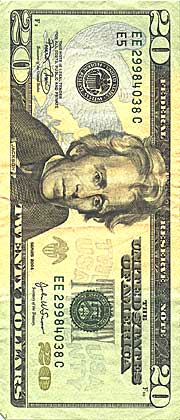 |
| One of the world's most recognized original editioned prints. |
 |
| The original print - as good as gold. |
 |
| A counterfit (reproductive) print - a worthless ruse intended to fool the unaware. |
 |
| Another print based on the original print - this time altered in order to make some sort of wacky "artistic" statement. Since it was never intended to be used as currency, it too becomes an original print. Editor's note: ("Original" does not necessarily denote meaningful - just original...) |
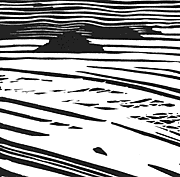 |
| The bold lines of a linocut, printed relief. |
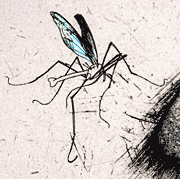 |
| The fine lines of a hard ground etching, printed intaglio. |
 |
| Aquatint creates a full tonal range from rich blacks to the palest greys. |
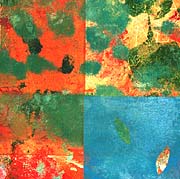 |
| Monotypes are unique original prints created from ink applied to a blank plate. |
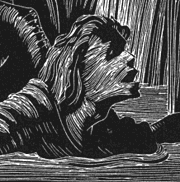 |
| The silvery lines of a relief etching. |
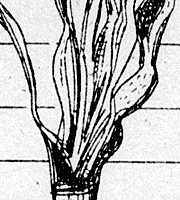 |
| The same etched plate printed intaglio (above) and relief (below). |
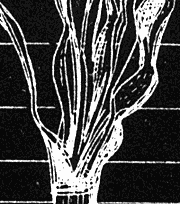 |
 |
| Different states of the same plate: State 1 (above) soft-ground etching State 2 (below) aquatint added |
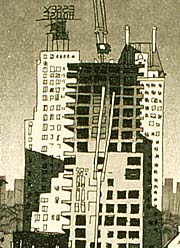 |
 |
| Each print in an edition is of the same quality. The numbering of the prints does NOT imply any greater or lesser intrinsic value. |
 |
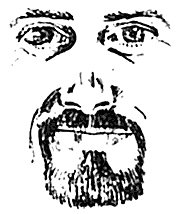 |